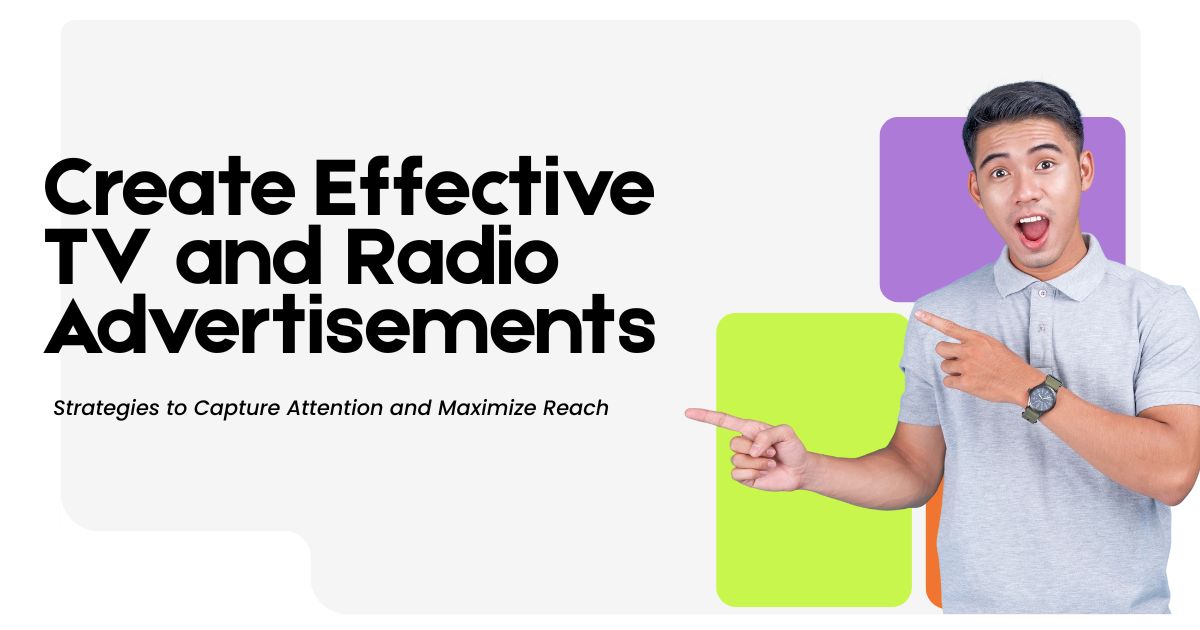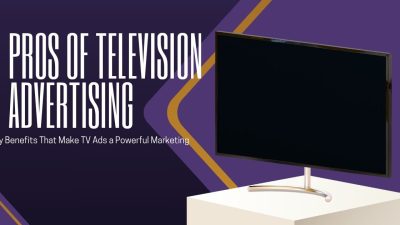Effective TV and radio ads take more than great visuals and a catchy jingle. Success is about getting to know your audience and communicating relevant messages, and serving up content that generates real business results. tv advertising. With the perfect plan of action, a TV or radio spot can change your brand and also supercharge your sales overnight.
This is a complete guide on how to make a television and radio advertisement that will penetrate the meaningless chatter, grab the attention of your demographic, and turn viewers or listeners into strong, loyal customers.
Television and Radio Advertising Continue to Work
Or take our TV and broadcast spots that can hit huge multiple audiences at the same time and create shared cultural moments that people have a harder time finding in digital. You can get your company in front of millions of potential customers with a single television or radio ad, at a scale that would take massive digital ad budgets to replicate.
With the passive nature of broadcast media, your ad is delivered to individuals who are in a relaxed, receptive state of mind. Where a digital ad stops your music or gets in between you and your online activities, TV and radio commercials blend in seamlessly between entertainment segments, meaning audiences are more receptive to whatever it is you’re saying.
Television and radio add credibility that some digital channels miss. “Consumers tend to trust advertising on big broadcast networks more than they do on social media or display,” Burford added.
Understanding Your Broadcast Audience
In advance of producing your advertising ad for TV or radio, you need to take time to know who will be consuming the media you are about to pay for. TV viewers and radio listeners are 2 different types of people; they’re different demographics and they act differently than people on other channels, and you should be taking your creative strategy from each.
Viewers at home, on the other hand, are generally more passive and visual. They are demanding–high production value, compelling storyline, and tangible visual representations of products or services. Radio listeners, however, are likely multitasking and depend solely on simple, non-verbal cues to receive your message.
Rating data and demographics for specific shows and periods. Early morning radio tunes in commuters seeking news and traffic, late-night TV lures in younger audiences looking for distraction. Match the content and tone of your ad to these different viewing environments.
Think about any seasonal or special event fluctuations that perhaps be influencing who is out there in the audience. (Holiday programming, sports seasons, and major news events can result in a big change in who is watching or listening, which can create an opportunity for targeting messaging.)
Setting Clear Campaign Objectives
Before you produce your TV or radio ad, set clear, quantifiable objectives. Popular goals are promoting the brand, bringing more visitors, creating leads, increasing sales, and introducing new products.
Branding/ Awareness No. This is how we generate Brand Awareness, one memorable ad and a huge amount of frequency at a time. Advertising of this sort is generally concerned with awareness and recall rather than action and aims to create long-term brand equity through frequency.
Direct response ads want action now and have the messaging that tells people exactly what to do, the incentive to do it, and the phone number or website to call. And best of all, when promoted with tracking, we can verify response rates and conversions.
Think about short-term and long-term goals when constructing your campaign. Though the immediate sales increases from ads are important, the long-term branding and increased customer loyalty justify ongoing ad expenditures.
Write Like You Talk – Compelling Scriptwriting for Broadcast Media
TV and radio scripts will be approached differently because they are their own medium. Television scripts combine the visual and aural audio of the production, while radio scripts describe everything in vivid detail, but are limited to using words, music, and sound effects to get the point across to the audience.
Begin with a strong hook that is attention-grabbing in the first few seconds. Television and radio audiences have unlimited alternatives; thus your intro needs to capture attention and create immediate interest to avert channel surfing.
Make one clear point rather than trying to express too much. In a broadcast commercial – typically, 15, 30, or 60 seconds – you have so little time to make that case, you need laser focus upon what you believe is arguably your most powerful sales point.
Use everyday English that can be read and spoken. It is a good idea to repeat your script at least five times to get the flow, pronunciation, and timing back into your voice. What looks good on the page might sound awkward on the stage.
Add clear calls-to-action that state what you want audiences to do next. Whether the action you want them to take is to visit a website, call a phone number, or visit a retail location, your call to action should be succinct and easy to remember.

Creating Effective Television Advertisements
By combining visual and audio messages, TV ads can convey products, emotion, and brand personality in a way that ads in other media cannot.
And invest in top-rate production values that reflect the professionalism and credibility of your brand. Even if your message is good, bad video quality, audio, and editing will make your business seem cheap or untrustworthy.
Demonstrate with visual shots how your product is used or what service you provide. Television being an all-or-nothing VISUAL medium that you could PROVE benefit (app DD but you were proving 2 benefits instead of claiming them).
Design your ad to play even if it is watched without sound, as many people are tuning in with the sound muted. Add text overlays for important information, leverage straightforward visual storytelling and find a way to deliver your message even when audio isn’t available.
Take into account the tech specs of various broadcast networks and streaming services. Outlets have different resolution needs, aspect ratios and file formats, so be sure to map that out in your production process.
Developing Compelling Radio Advertisements
Radio ad campaigns are based strictly on the potential to stimulate mental pictures and establish relationships with listeners through verbal cues. But to do so, you need to be wise about how you employ voice, tone, music, sound effects and pacing in order to conjure the imagination of your listeners.
Select voice talent that reflects your brand’s personality as well as your target audience. Warm and friendly voices do well for businesses with a family focus, while commanding voices pair well with professional services. Take into account viewer age, gender, and regional accents.
Leverage music tactically to establish mood and increase rememberability. Background music needs to underpin your message without overshadowing it, and jingles can form strong relationships with your brand that stay in the listener’s head long after the ad has finished.
Use limited sound effects for ambiance or to help illustrate important points. Creative sound design can transport your listeners to that beach or to that party, bringing your ad copy to life in ways that engaging and memorable.
Change your pace frequently, so listeners stay engaged in the ad. Switch back and forth between faster, more fast-pace type of sections and slower, more thoughtful type of scenes to break up the rhythm and not be monotonous.

Timing and Placement Strategies
Where you position your TV or radio ad makes a big difference in its effectiveness. (Peak TV slots are expensive, but they also come with a lot more eyeballs; off hours have smaller audiences, but also a smaller CPM).
Find out the time your audience will most likely be watching or listening. Business-to-business ads might do better during morning commutes, while consumer goods may be more effective during daytime programming.
When choosing placement options, think about programming offered. Financial service ads may do well during business news segments. Family products may be a hit during clean entertainment programs.
Try out various times and formats until you find what works best for your business. What works for one company won’t necessary work for another one, so collect performance data and use those performance-based metrics to inform future placements.
Measuring Advertisement Performance
Monitor important factors to see how your television or radio ad is performing and what can be done to make it more successful. Reach, frequency, recall and direct response rates are among the most commonly used measurements.
Track responses that can be clearly tied to your broadcast ad (by unique phone numbers, website URLs or promo codes). This is a direct measurement that can help justify the costs of advertising and also make future advertising campaigns more efficient.
Conduct brand awareness pre and post ad surveys to quantify any shifts in Unaided, Aided and top-of-mind awareness. This research considers excellent analysis of long term brand building effects that don’t necessarily show up in immediate response metrics.
Track website traffic, social activity, search for brand terms as your advertisement is airing and subsequently. They show other impacts of the ad beyond the pure response measures.
Bridging the Gap Between Broadcast Advertising and Digital Marketing
Integrate your TV or radio ads with a digital marketing strategy for superior campaign performance. Leverage new age media to maximize ad reach, generate online discussions and offer additional engagement avenues.
Design landing pages exclusively for broadcast ad traffic. These pages should only serve to support/refine your ad message and create a clear path to conversion for an interested visitor.
Leverage search engine marketing to capture incremental search volume driven by successful broadcast campaigns. Place bids on relevant keywords and develop ads that resonate with your broadcast messaging.
Develop content marketing pieces around themes presented in your TV or radio spot. You can complement your broadcast communication with blog posts, videos, social media, etc., to give an additional value.
Final Thoughts: Creating Success With Broadcast Advertising – The Long Term
Imagine you’re reading an article and it stops halfway through.
Never produce a broadcast (TV or radio) ad without establishing who you’re trying to reach and what you want to say. Ambiguous advertisements that attempt to speak to the masses generally end up speaking to no one.
Stop trying to shove 10 pounds of information in a 5 pound time slot. There’s only so much information that your listeners and viewers will be able to process in 30 or 60 seconds, so don’t try to run down a list of every benefit—zero in on your most compelling selling point.
Do not underestimate the value of repetition in broadcasting advertising. You traditionally won’t get much bang for your buck by running your ad a single time or twice. Plan for the vailability of multiple ads and air over months for notice and recall.
Make certain your advertisement features easy-to-remember contact information. Ensure numbers, websites, store locations are easy to remember and prominently displayed in advertisement.
Developing a successful television or radio ad takes time and careful planning, with the end result focusing on both attention and audience. Start with a solid purpose, have some production value, and concentrate on providing value to your listeners or viewers.
The secret to success with broadcast advertising is to keep in mind that TV and radio ads are really relationship builders, they’re not just announcements. Concentrate on establishing winning brand preferences and emotional bonds that induce sustained customer loyalty.
Keep in mind that broadcast advertising is most effective as part of an overall marketing program. Done right with the right audience and message, a TV or radio ad can buy big business and leave behind the kind of brand and customer value that is hard to measure.
Creating a television or radio advertisement that actually works goes hand in hand with strategies like referral marketing, both aimed at increasing brand visibility and driving sales through targeted messaging.





